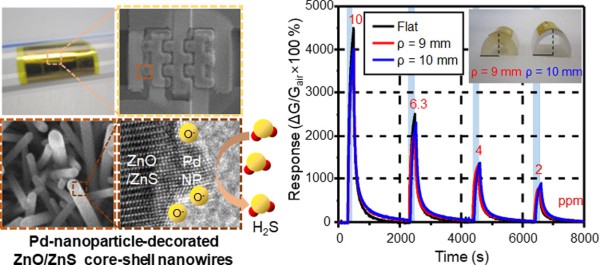Gas Sensor by Direct Growth and Functionalization of Metal Oxide/Metal Sulfide Core–Shell Nanowires on Flexible Substrates
- Journal
- ACS Applied Materials & Interfaces
- Vol. (No.), pp.
- 11 (27), 24298-24307 (Jul 2019)
- Year
- 2020-2014
We have developed a novel fabrication method for flexible gas sensors for toxic gases based on sequential wet chemical reaction. In specific, zinc oxide (ZnO) nanowires were locally synthesized and directly integrated on a flexible polymer substrate using localized hydrothermal synthesis methods and their surfaces were selectively functionalized with palladium (Pd) nanoparticles using a liquid phase deposition process. Because the entire process is conducted at a low temperature in a mild precursor solution, it can be applied for flexible substrates. Furthermore, the surface of ZnO nanowires was sulfurized by hydrogen sulfide (H2S) gas to form zinc oxide/zinc sulfide (ZnO/ZnS) core–shell nanowires for stable sensing of H2S gas. The locally synthesized ZnO/ZnS core–shell nanowires enable an ultracompact-sized device, and Pd nanoparticles improve the sensing performance and reduce the operating temperature (200 °C). The device shows a high sensitivity [(Ggas – Gair)/Gair × 100% = 4491% to 10 ppm], fast response (response/recovery time <100 s) to hydrogen sulfide, and outstanding selectivity (>100 times) to other toxic gases (e.g., carbon monoxide, acetone, ethanol, and toluene). Moreover, vertically synthesized nanowires provide a long bending path, which reduces the mechanical stresses on the structure. The devices showed stable gas sensing performance under 9 mm positive radius of curvature and 5 mm negative radius of curvature. The mechanical robustness of the device was also verified by numerical simulations which showed dramatic decrease of maximum stress and strain to 4.2 and 5.0%, respectively.


